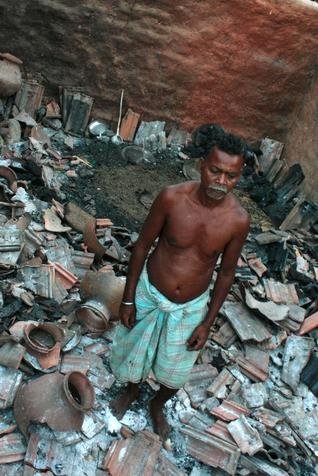Chhattisgarh villages torched in police rampage (The Hindu)
“The operation began in the early hours of March 11 when about 350 heavily armed troopers marched into the forests of Dantewada. They returned to their barracks five days later, with three villages aflame, about 300 homes and granaries incinerated, three villagers and three security personnel dead, and three women sexually assaulted, the victims and several eyewitnesses told The Hindu.
“Last week, the Chhattisgarh police said three Koya commandos were killed in a Maoist ambush during a routine search, yet journalists attempting to reach the site were turned away by gun-toting special police officers. On visiting the area through a forest route, this correspondent was confronted by the aftermath of what appeared to be an attack by security forces on three tribal settlements in a 15-km radius of the police camp at Chintalnar, which has left hundreds homeless and brutalised. [...]
“Villagers say the force left by noon, having torched 37 houses. They also picked up Madavi Ganga, 45, his son Bima and his daughter Hurre, 20. ‘They took us to the Chintalnar police station and put me in a separate cell and stripped me,’ said Hurre.
“Hurre said she was kept all night in the station and sexually assaulted. Ganga and Bima said the police repeatedly asked them whether Maoists visited their village, and beat them through the night. The Madavi family was released when the women of Morpalli demanded their release at the Chintalnar station.
“Police sources say they found neither arms factories nor Maoists at Morpalli that day, though they did find a 15-foot memorial commemorating the death of eight Maoists in the April 2010 encounter, in which 76 CRPF troopers were killed near Tarmetla village.”
See also:
Scorched-Earth Tactics Return to Chhattisgarh by Eric Randolph (Current Intelligence, March 23, 2011):
“I saw the effect of these operations for myself when I travelled to the area recently. Trauma and fear pervades everyday life for these tribal communities. Whenever an outsider appears on the outskirts of a village, everyone prepares to flee. Only when they recognised our guide did they calm down. [...]
“An ongoing case in the Supreme Court has collected testimonies implicating the state’s security forces in the deaths of 537 people, including 33 children, as well as 99 rapes and the destruction of at least 2,825 houses. These testimonies relate only to the period between 2005 and 2007, when the violence was at its peak. The difficulty of reporting in this remote region means the figures cannot be exactly accurate – and the real numbers could be far higher. A large number of attacks have occurred since then as well and, it would appear, are continuing.
“In its early phase, the violence was fuelled by the formation of an anti-Maoist movement called the Salwa Judum, set up in 2005 by local elites keen to regain control of the region and its resources. The Judum quickly gained the backing and support of the police and the government, but by arming local tribals and seeking to divide communities, it triggered a spiral of brutal violence.
“The Judum held processions through the forests, forcibly relocating people to camps under police control. Evidence in the Supreme Court case states that 47,238 people were moved to the camps. The numbers have been steadily reduced to around 25,000 according to the Chhattisgarh government, spread across 23 camps. The majority of those remaining had joined the Salwa Judum and now fear reprisals from the Maoists and their fellow villagers if they return to their homes.”
And see:
In Dantewada, poor fight poor in a dehumanising war (Times of India, March 24, 2011):
“Newspaper images from the villages showed men and women staring at the charred ashes of their homes, food grains, belongings and lives. ‘What will we eat this year? All our grain is lost,’ former sarpanch Nupo Muta was quoted in Patrika, a Hindi daily. The paper reported 300 homes had been torched, five men killed and three women sexually assaulted.
“Between 2005-2007, villages here witnessed intense and savage clashes between Salwa Judum and the Maoists.
“Salwa Judum is translated as 'peace march' by some and as 'purification hunt' by others. This dichotomy of definition extends to accounts of how it began and what followed.
“Judum supporters claim it was a spontaneous upsurge by adivasis – fed up of Maoist diktats, they declared rebellion, moving out of their villages, to escape the wrath of rebels.
“But critics allege it was a government backed militia that launched brutal attacks on villages, forcing thousands to abandon their homes, in a ‘scorched earth' strategy, aimed at exposing rebel hideouts and cutting their supplies.
“Whatever be the truth, either way, the clashes of those years left the area brutally ruptured.
“Thousands moved to refugee camps along NH 221. Others stayed back – but found themselves abandoned by the government, as schools, health centres, anganwadis, every wing of the civil administration folded up in the villages.
“Last October, the state government informed the Supreme Court that Salwa Judum no longer exists. But this week, the rampage came as a reminder of its enduring legacy.”


Comments